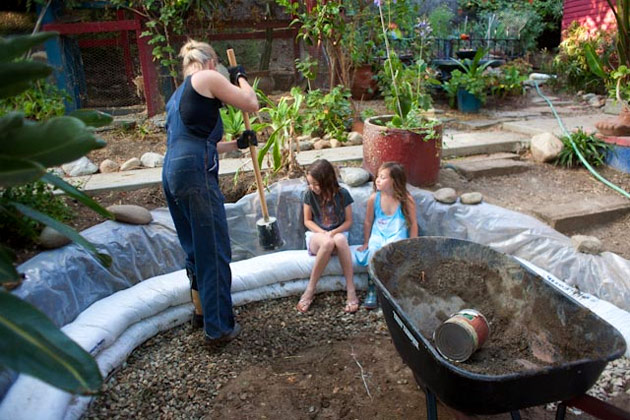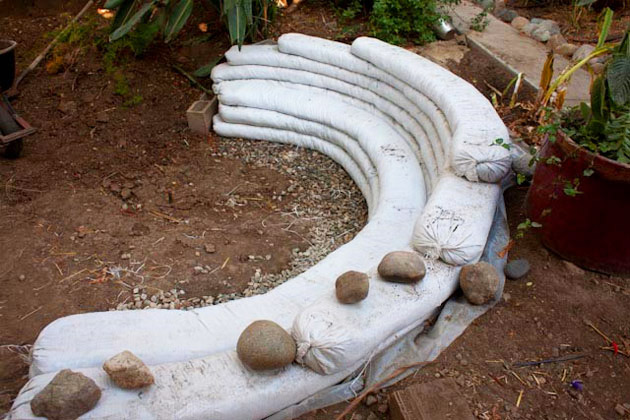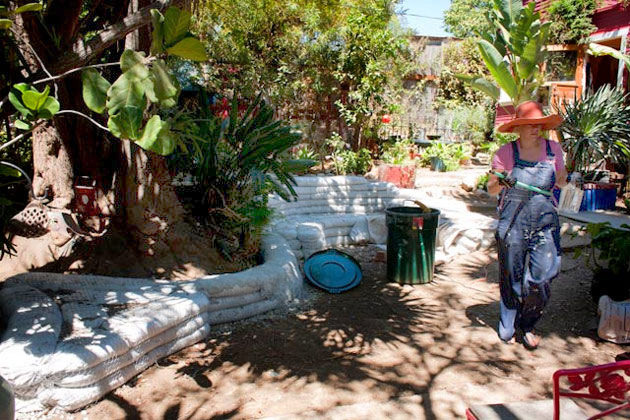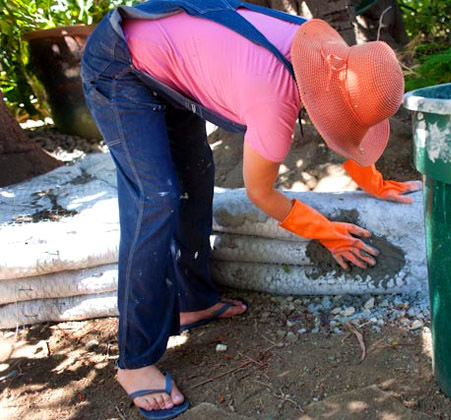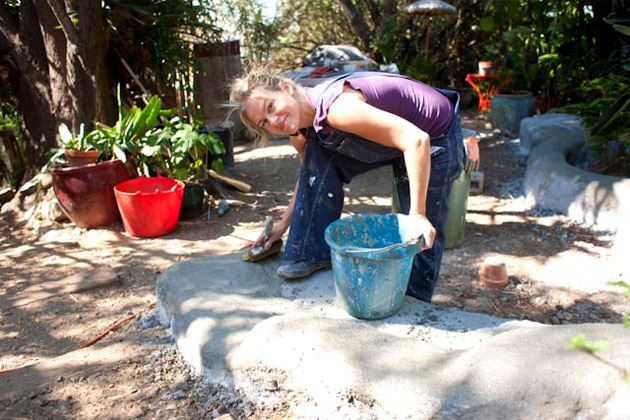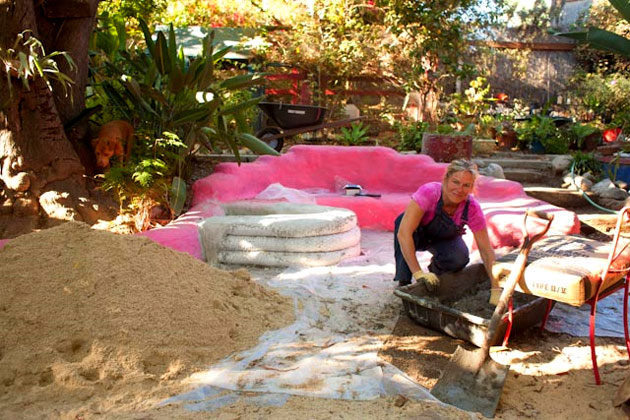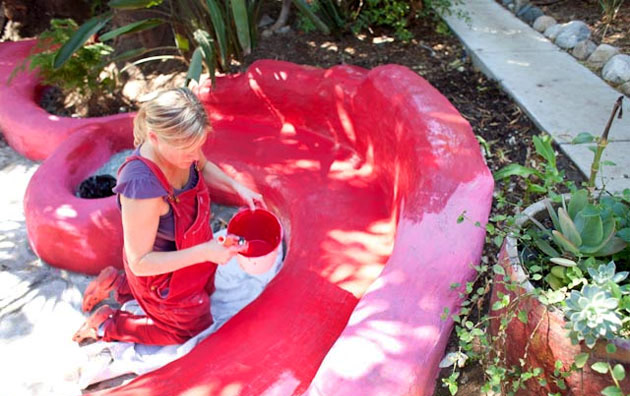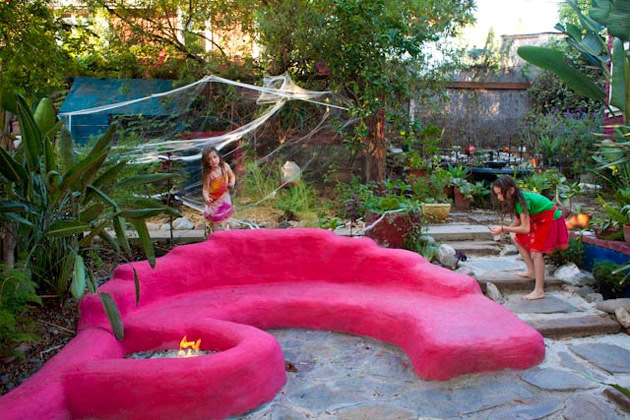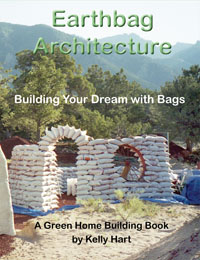| Building a Fire Pit and Seating Area by Lisa Boone |
Ilse Ackerman of Los Angeles built an outdoor lounge area with fire pit using books, Internet advice, YouTube and her own thriftiness. Inspired by Mark Frauenfelder's do-it-yourself book, "Made by Hand: Searching for Meaning in a Throwaway World," Ackerman built the project in three months with inexpensive soil-filled sacks called earthbags. The result: a quirky backyard feature that Ackerman, husband Meeno Peluce and daughters Mette and India Peluce can enjoy. Here's a step-by-step look at how Ackerman built it.
"Anything is doable," Ilse Ackerman declared recently from her Lincoln Heights backyard. Ackerman holds a homemade "rammer" -- a yogurt cup filled with earth, cement and water. The building blocks for her seating area and fire pit are dirt- and cement-filled polypropylene tubes called earthbags, which she bought from the California Institute of Earth Art and Architecture, or Cal-Earth. "When you put the dirt and concrete in, it is not completely even," she said. "You use the rammer to get it down to the same thickness. Once it's compacted, it has that concrete feeling." Ackerman notes that the first piece, shown here, was short. "I didn't take in to account that there would be bunching," she said.
Ackerman rams the second layer of tubing while daughters India, left, and Mette look on. Ackerman recommends working in a team. "It would go much quicker if there is someone to fill the bag, tamp the ends and ram," she said. "Holding the bag and tamping at the same time is hard." The gravel base helps with drainage. Ackerman filled the polypropylene bags with dirt from the excavated area via a sono-tube and tamped the ends. Because she was working alone, the project went slowly.
The earthbags are nine parts dirt and one part cement. She mixed the ingredients in a wheelbarrow and then shoveled the material into the bags using a Sonotube concrete form bought at Home Depot. In between each layer, she placed barbed wire, to keep the layers from shifting.
When she wasn't working on the project, Ackerman covered the polypropylene bags with a drop cloth and rocks. "It will break down in three weeks of direct sun without a protective covering," she said. After the base of the structure was finished, she covered it with chicken wire. To the left, Ackerman created a raised platform where her daughters can play.
Ackerman applies the first rough coat of concrete Spec Mix, followed by a super smooth coat.. She mixed the material in a trash can with a cement mixer attachment on her drill. Ackerman preferred working with her hands and not a trowel.
It took a few days to cover the structure with Spec Mix. "At that point it went fast because it dries quickly," Ackerman said. "You moisten it -- not too wet, not too dry -- feed it, and as it hardens in you ramp it down."
Ackerman applies water to the Spec Mix to keep it moist and smooth. "You have to wet it while it is drying," she said. "It's similar to ceramics where you have to keep applying moisture so the clay doesn't dry out too quickly and crack."
When it came to color, Ackerman was unhappy with the terra cotta pigment she first applied. "It wasn't enough of a statement," she said. So she began researching lime wash, which she had heard was weather- and rot-resistant. "Over time it develops a much more beautiful aged finish," she said. The only problem? "It is almost impossible to find lime wash," she sighed. She finally found Australian lime wash at Jill's Paint in Atwater Village. The clerk's advice: "Go darker," prompting her to choose a deep Indian pink. Ackerman installed the fire pit in the corner, attached to the seating area. "I thought I was going to make the fireplace a doughnut in the center but decided it was not going to feel roomy enough," she said.
Ackerman applies Spec Mix to the fire pit. She now acknowledges that she was not completely sold on the earthbags until she started applying the smooth coat. "It was then that I started feeling like it was going to be OK," she said. "I was looking at it and thinking, 'This looks terrible,'" she said. "It looked like weird white tubes until I tacked down the chicken wire."
Two coats of Indian-pink lime wash make a statement.
The playful environment is a hit with her family and even inspired Ackerman to install a new flagstone and cement patio. True to her do-it-yourself project, she rented a jackhammer and took up the original patio herself. "It was not as hard as I thought," she said. Today, Ackerman is pleased with the results of her hard labor, which she estimates cost under $1,000. She is also honest about tackling another such project alone: "I could never do it again," she said.
"It's been a nice addition to our yard," she said. "The girls love it. They wanted a dedicated couch area. And it's great to be in the hot tub and sit next to the fire." |
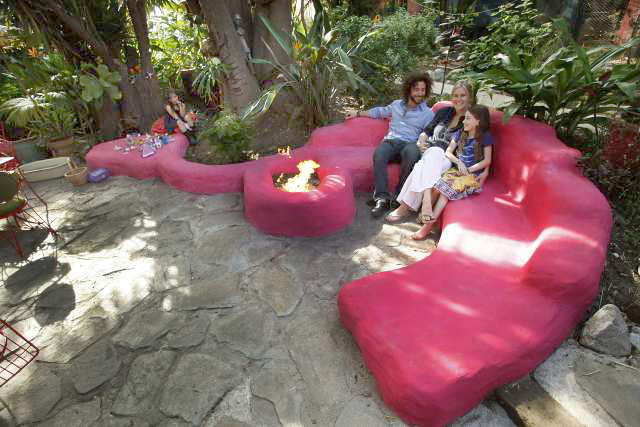 (above photo by Kirk McKoy / Los Angeles Times; all other photos by Meeno Peluce.)
(above photo by Kirk McKoy / Los Angeles Times; all other photos by Meeno Peluce.)
